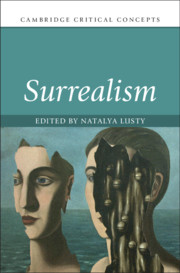Book contents
- Surrealism
- Cambridge Critical Concepts
- Surrealism
- Copyright page
- Contents
- Illustrations
- Notes on Contributors
- Acknowledgments
- Introduction: Surrealism’s Critical Legacy
- Part I Origins: Ideas/Concepts/Interventions
- Chapter 1 The Surrealist World
- Chapter 2 Psychoanalysis
- Chapter 3 Surrealism and the Demand of Politics
- Chapter 4 Modern Science
- Chapter 5 Surrealism and Dreams
- Chapter 6 Surrealism and Eros
- Part II Developments: Practices/Cultures/Material Forms
- Part III Applications: Heterodoxies and New Worlds
- Select Bibliography
- Index
Chapter 5 - Surrealism and Dreams
from Part I - Origins: Ideas/Concepts/Interventions
Published online by Cambridge University Press: 23 July 2021
- Surrealism
- Cambridge Critical Concepts
- Surrealism
- Copyright page
- Contents
- Illustrations
- Notes on Contributors
- Acknowledgments
- Introduction: Surrealism’s Critical Legacy
- Part I Origins: Ideas/Concepts/Interventions
- Chapter 1 The Surrealist World
- Chapter 2 Psychoanalysis
- Chapter 3 Surrealism and the Demand of Politics
- Chapter 4 Modern Science
- Chapter 5 Surrealism and Dreams
- Chapter 6 Surrealism and Eros
- Part II Developments: Practices/Cultures/Material Forms
- Part III Applications: Heterodoxies and New Worlds
- Select Bibliography
- Index
Summary
This chapter examines the emergence of a dream aesthetic in the orbit of Surrealism. While André Breton’s “Manifesto of Surrealism” (1924) and Louis Aragon’s “Wave of Dreams” (1924) point to the dream as a catalyst for a new kind of imaginative freedom, free of moral or aesthetic judgement, it was in Communicating Vessels (1932) that Breton brought the dream into direct correspondence with urban wandering and objective chance. In the process, Breton identified how the manifest content of his dreams drives an affective and sensorial attunement to people and places in the urban street, revealing the cathectic forces driving our aleatory engagement with the material world, and thereby assigning the dream a more critical, indeed, political cast. The second part of the chapter turns to the striking affinities between the dream and film uncovered by Surrealism, via the symbolic mapping of the Freudian dream in Buñuel and Dalí’s Un chien andalou (1929) and the melodramatic tension between symbolic objects and unconscious bodily movement in Maya Deren’s Meshes of the Afternoon (1943).
Keywords
- Type
- Chapter
- Information
- Surrealism , pp. 94 - 111Publisher: Cambridge University PressPrint publication year: 2021

